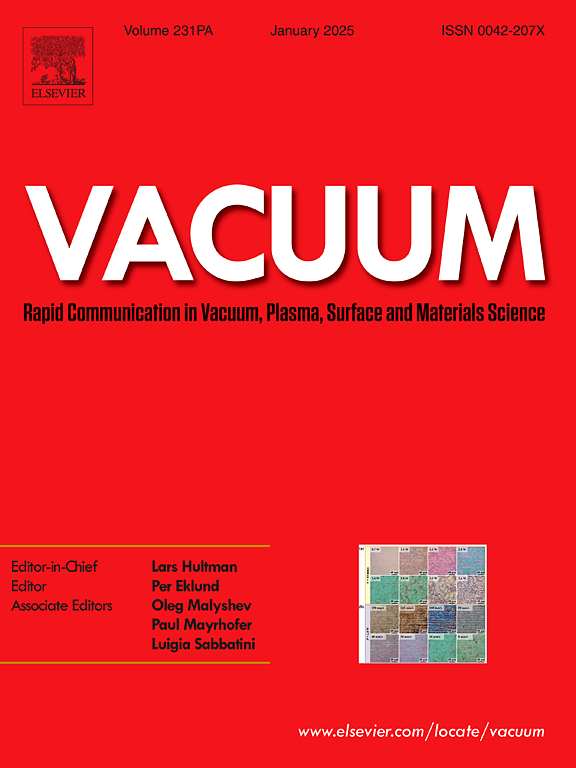ICP-RIE etching of MESA and trench SiC structures in SF6 + O2 plasma: significant difference in SiC etching rate dependence on oxygen content
IF 3.9
2区 材料科学
Q2 MATERIALS SCIENCE, MULTIDISCIPLINARY
引用次数: 0
Abstract
Silicon carbide (SiC) is an attractive semiconductor with many excellent properties that can bring huge potential advances in submicron semiconductor processing technology. The inductively coupled plasma reactive ion etching (ICP-RIE) method is widely used in the fabrication technology of various semiconductor devices. The paper presents the results of the ICP-RIE etching of SiC trench or MESA structures. The influence of O2 addition to the SF6 plasma on the etching process of these structures is reported. Etched SiC structures are studied by SIMS, SEM, XPS and stylus profilometry. It will be shown that MESA and trench structures have different dependences of the SiC etching rates depending on O2 content. For trench structures, the initial decrease in the SiC etching rate under increased oxygen content is observed which differs from the trend of MESA dependences obtained in this work, and also reported in the literature. For both types of these structures, the paper presents a possible explanation of the difference in their characteristics of the SiC etching rate on the oxygen content in SF6 + O2 gas mixture.
在SF6 + O2等离子体中MESA和沟槽SiC结构的ICP-RIE刻蚀:SiC刻蚀速率随氧含量的显著差异
碳化硅(SiC)是一种极具吸引力的半导体材料,具有许多优异的性能,在亚微米半导体加工技术中具有巨大的发展潜力。电感耦合等离子体反应离子刻蚀(ICP-RIE)方法广泛应用于各种半导体器件的制造技术中。本文介绍了ICP-RIE刻蚀SiC沟槽或MESA结构的结果。报道了在SF6等离子体中加入O2对这些结构蚀刻过程的影响。利用SIMS、SEM、XPS和触笔轮廓仪对蚀刻SiC结构进行了研究。结果表明,随着O2含量的不同,MESA和沟槽结构对SiC刻蚀速率有不同的依赖性。对于沟槽结构,在氧含量增加的情况下,观察到SiC蚀刻速率的初始降低,这与本工作中获得的MESA依赖性趋势不同,也在文献中报道过。对于这两种结构,本文给出了一种可能的解释,解释了它们的SiC蚀刻速率特征对SF6 + O2气体混合物中氧含量的差异。
本文章由计算机程序翻译,如有差异,请以英文原文为准。
求助全文
约1分钟内获得全文
求助全文
来源期刊

Vacuum
工程技术-材料科学:综合
CiteScore
6.80
自引率
17.50%
发文量
0
审稿时长
34 days
期刊介绍:
Vacuum is an international rapid publications journal with a focus on short communication. All papers are peer-reviewed, with the review process for short communication geared towards very fast turnaround times. The journal also published full research papers, thematic issues and selected papers from leading conferences.
A report in Vacuum should represent a major advance in an area that involves a controlled environment at pressures of one atmosphere or below.
The scope of the journal includes:
1. Vacuum; original developments in vacuum pumping and instrumentation, vacuum measurement, vacuum gas dynamics, gas-surface interactions, surface treatment for UHV applications and low outgassing, vacuum melting, sintering, and vacuum metrology. Technology and solutions for large-scale facilities (e.g., particle accelerators and fusion devices). New instrumentation ( e.g., detectors and electron microscopes).
2. Plasma science; advances in PVD, CVD, plasma-assisted CVD, ion sources, deposition processes and analysis.
3. Surface science; surface engineering, surface chemistry, surface analysis, crystal growth, ion-surface interactions and etching, nanometer-scale processing, surface modification.
4. Materials science; novel functional or structural materials. Metals, ceramics, and polymers. Experiments, simulations, and modelling for understanding structure-property relationships. Thin films and coatings. Nanostructures and ion implantation.
 求助内容:
求助内容: 应助结果提醒方式:
应助结果提醒方式:


